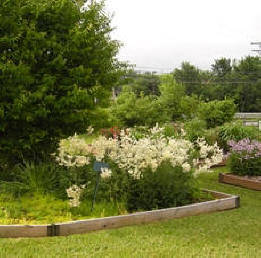(7/25/2016) If you have gardened for any length of time you already realize that your garden is always going through changes—some for the better and some for the worst. Taking climate change into consideration, you probably already know that some plants and seeds can be planted earlier in the spring and will last longer into the fall; maybe you are
able to plant perennials that previously didn’t grow in your area—lupine comes to mind for me. I used to try every year to plant this beautiful perennial and it wouldn’t last, but lately my plants have reseeded themselves and I have several plants now—in two different locations. Alyssum, that early-spring annual now lasts most of the summer because of improvement and it
stays low to the ground throughout the summer. It is now easy to grow rosemary (Arp) that will last through a ‘normal’ winter, especially in a south-facing location.
Aside from these climate-changing examples, there is another factor in why your garden will change over time. Trees! What started out in my garden as a mostly sun-loving garden years ago has now changed in one location in my yard. I now have a very large pin oak which dictates what plants are near it. The oak was from an acorn that took root more
than 20 years ago. Since it was hard to pull out, I left it grow. Now I have a 30- to 40-foot tree and a large shade garden under it. Oaks are easier to plant under than a maple tree—I am able to plant ferns and other shade-loving plants right up to the trunk and they thrive. This is where I have a sampling of different hostas, Japanese forest grass, an oak-leaf
hydrangea, Solomon’s Seal, Maidenhair fern, and a low-growing sedge (Pennsylvania sedge). Having this large oak has not been kind to the 50-year old lilac shrub that is also under its branches. The flowers are much smaller and not as numerous as they were when the shrub was in sun.
 Another example of a sun garden reverting to shade is at the Trial Garden at the Ag. Center in Gettysburg. Master Gardeners have gardened in this space since the early 2000s. Approximately 2008 we planted two American hornbeam trees (Carpinus caroliniana) that were very small in the two
triangles that are at the top of the trial garden. Along with the two small trees we planted some spring bulbs, creeping phlox, perennial geraniums (cranesbill), perennial salvias, gallardia ‘Arizona Sun,’ and celosia. Three potentilla shrubs were also planted in each triangle. After a couple years we also planted ceratostigma or perennial plumbago under the trees. Now in
2016 the plumbago has enlarged and followed the shade outline of the trees which are now about 15 to 20 feet tall and very wide; in one garden it almost fills the triangle. The outer edges of the the bed still has gallardia, a smaller plot of the phlox, some lupine which now grows very well, and a large expanse of Geranium biokova or perennial cranesbill.
Another example of a sun garden reverting to shade is at the Trial Garden at the Ag. Center in Gettysburg. Master Gardeners have gardened in this space since the early 2000s. Approximately 2008 we planted two American hornbeam trees (Carpinus caroliniana) that were very small in the two
triangles that are at the top of the trial garden. Along with the two small trees we planted some spring bulbs, creeping phlox, perennial geraniums (cranesbill), perennial salvias, gallardia ‘Arizona Sun,’ and celosia. Three potentilla shrubs were also planted in each triangle. After a couple years we also planted ceratostigma or perennial plumbago under the trees. Now in
2016 the plumbago has enlarged and followed the shade outline of the trees which are now about 15 to 20 feet tall and very wide; in one garden it almost fills the triangle. The outer edges of the the bed still has gallardia, a smaller plot of the phlox, some lupine which now grows very well, and a large expanse of Geranium biokova or perennial cranesbill.
The power of shade is impressive in a garden and should not be ignored. If you continue to plant sun-loving plants where there is a lot of shade, you will be a frustrated gardener.
There will be two more Garden Chats held at the Trial Gardens on August 3 and September 14. Both talks will begin at 6 p.m. If you haven't seen the gardens this summer use these opportunities to learn about what we Master Gardeners are working on now. Shade changes a garden but so do the gardeners who plan their gardens every year. We have new
gardeners who take a plot and we have gardeners who plant the same plot every year but put different plants in it. It is a chance for a gardener to experiment and evaluate something new or something they can't grow at their home garden.
We now have a bird garden--all the plants are there to provide seeds for birds; some of the plants will linger through the winter to continue providing food for birds. After several years, we have a new lavender garden filled with many types of lavender. Another plot is filled with every imaginable zinnia and they are blooming very well. By the
time you visit more goldenrod plants should be blooming. And you can follow our progress at counting bees on the Monarda and Coreopsis plants in order to record the number of carpenter bees, bumble bees, honey bees, and small dark bees that visit these two types of plants.
Our hedgerow is still expanding with more native plants added this year. And take a look at the Community Gardens while you are here. Gardening is truly an activity everyone can enjoy--even if it means just observing what is growing.
Read other articles on garden and landscape design
Read other articles on plants and gardens